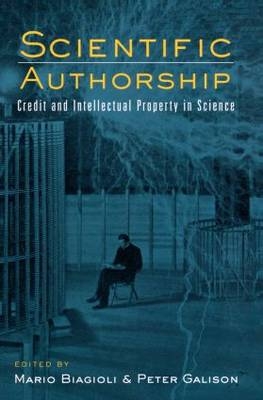
Scientific Authorship
Routledge (Verlag)
978-0-415-94292-8 (ISBN)
Since the seventeenth century our ideas of scientific authorship have expanded and changed dramatically. In this ambitious volume of new work, Mario Biagioli and Peter Galison have brought together historians of science, literary historians, and historians of the book. Together they track the changing nature and identity of the author in science, both historically and conceptually, from the emergence of scientific academies in the age of Galileo to concerns with large-scale multiauthorship and intellectual property rights in the age of cloning labs and pharmaceutical giants. How, for example, do we decide whether a chemical compound is discovered or invented? What does it mean to patent genetic material? Documenting the emergence of authorship in the late medieval period, authorship's limits and its fragmentation, Scientific Authorship offers a collective history of a complex relationship.
Mario Biagioli is Professor of the History of Science at Harvard and author of Galileo, Courtier. He is editor of The Science Studies Reader (Routledge). Peter Galison is Mallinkrodt Professor of the History of Science at Harvard. He is the author of several books, including Image and Logic and is editor, with Caroline Jones, of Picturing Science, Producing Art (Routledge).
Introduction, Mario Biagioli, Peter Galison; Part I Emergence of Authorship; Chapter 1 Foucault’s Chiasmus, Roger Chartier; Chapter 2 Butter for Parsnips, Rob Iliffe; Chapter 3 The Ambivalence of Authorship in Early Modern Natural Philosophy, Adrian Johns; Chapter 4 The Uses of Anonymity in the Age of Reason, Mary Terrall; Chapter 5 Can Artisans Be Scientific Authors?, Myles W. Jackson; Chapter 6 “A Very Hard Nut to Crack”, Andrew Warwick; Part II Limits of Authorship; Chapter 7 Emergent Relations, Marilyn Strathern; Chapter 8 Beyond Authorship, Peter Jaszi, Martha Woodmansee; Chapter 9 Uncommon Controversies, Corynne Mcsherry; Part III The Fragmentation of Authorship; Chapter 10 Rights or Rewards?, Mario Biagioli; Chapter 11 The Death of the Authors of Death, Hugh Gusterson; Chapter 12 “Discourses of Circumstance”, Hans-Jörg Rheinberger; Chapter 13 The Collective Author, Peter Galison; Part IV Commentaries; credits End Credits, Tom Conley; author What Is Not a Scientific Author?, Mark Rose;
| Erscheint lt. Verlag | 19.12.2002 |
|---|---|
| Verlagsort | London |
| Sprache | englisch |
| Maße | 152 x 229 mm |
| Gewicht | 890 g |
| Themenwelt | Geisteswissenschaften ► Geschichte |
| Geisteswissenschaften ► Philosophie | |
| Geisteswissenschaften ► Sprach- / Literaturwissenschaft ► Anglistik / Amerikanistik | |
| Geisteswissenschaften ► Sprach- / Literaturwissenschaft ► Literaturwissenschaft | |
| Naturwissenschaften ► Biologie ► Ökologie / Naturschutz | |
| Sozialwissenschaften | |
| ISBN-10 | 0-415-94292-6 / 0415942926 |
| ISBN-13 | 978-0-415-94292-8 / 9780415942928 |
| Zustand | Neuware |
| Haben Sie eine Frage zum Produkt? |
aus dem Bereich


